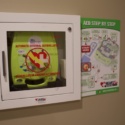Automated external defibrillators (AED) are becoming more and more popular in schools and institutions.
Thames Valley District School Board in London, Ont. is Southwestern Ontario’s largest school board, with 150 educational institutions involved. Only 16 out of the 157 are equipped with the life saving device.
An AED is a small portable device that will provide a small electrical shock to defibrillate the heart and restore the normal rhythm. These devices, located in most buildings now, also offer verbal instructions to non-trained individuals so that everyone is able to provide this lifesaving aid.
The push for more units came to light after a 12-year-old boy passed away due to irregular breathing. He passed away in Northport, New York during a lacrosse game in 2000. His family is now pushing to have training on how to do CPR and how to use AEDs in schools.
Ontario’s Education Ministry says that each school board is its own individual and they must choose what to do.
The Grand Erie School Board, located in Brantford, Ontario, states in their policy that “Public Access Defibrillators are located at all Grand Erie School Board facilities and are available in the event of an emergency.”
Staff and students of the Thames Valley District School Board are pushing to get more units in more schools.
Another policy, written up by the City of Brantford and the Brant County, stated that AEDs are located in all schools for the safety of staff, students and faculty.
The policy by the City of Brantford and Brant County states that custodial staff should visually inspect the AED units daily during school hours to make sure they are functional.
Richard Hoffman, public affairs coordinator for the Thames Valley District School Board, was contacted in regards to the lack of sufficient AEDs in schools. Hoffman did not directly answer the question.
The City of Brantford and the Brant County have installed AEDs in all schools as part of an initiative with the Heart and Stroke Foundation.
According to the Heart and Stroke Foundation’s website, AEDs are now becoming as common as fire extinguishers, with over 20,000 AEDS in communities across the nation.
The website states, “When cardiac arrest happens, every minute counts. If delivered in the first few minutes of a cardiac arrest, defibrillation and cardiopulmonary resuscitation (CPR) can double survival rates. But with each passing minute, the probability of survival decreases by seven to 10 per cent.”
In February of 2013, the Heart and Stroke Foundation received funding from then Prime Minister Stephen Harper to put AEDs in hockey arenas and recreational centers across Canada.
Every year, about 40,000 cardiac arrests happen in Canada, that’s one every 13 minutes.




